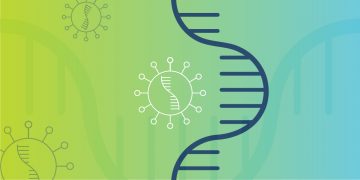
Immune Surveillance in SARS-CoV-2 Vaccine Development
The ability to characterize the target of cell-mediated immune response is crucial during vaccine development. In studying the characterization of SARS-CoV-2 infection pathogenesis in humans, a research team identified neutralizing antibodies that provided context for vaccine antigen design. Discover how the ZE5 Cell Analyzer was used to detect activation-induced markers, measure intracellular cytokines, and identify spike protein–specific antibodies in a rapid, high-throughput manner.

Countering COVID-19 with the Launch of Two New RT-PCR Kits
Bio-Rad is proud to introduce our new RT-PCR testing kits for COVID-19. These all-in-one kits are designed for sensitive, specific detection of SARS-CoV-2 alone, or simultaneous detection of SARS-CoV-2, influenza A, and influenza B. Read on to learn about each kit’s features.

Immunological Response Factors to SARS-CoV-2 in Acquired Immunity
Multiple publications report variation in the duration of acquired immunity to SARS-CoV-2. In this webinar, Bio-Rad scientists review these reports and discuss factors that influence longevity of acquired immunity. Learn about the mechanisms behind acquired immunity and how cytokine and chemokine activity, preexisting conditions, and more can affect immunity duration.

Top Questions from Our Wastewater Surveillance Webinar
The COVID-19 pandemic has captured the attention of the world and won’t let go. And that has sparked efforts for creative solutions in some surprising places. Wastewater is not where most peoples’ minds go first when they think of airborne diseases, but it holds much promise for tracing and predicting SARS-CoV-2 outbreaks.

Are biofuels good for the planet?
Will the trend toward using biofuels benefit the earth? Listen in as our Chromies team discusses different types of biofuels and how chromatography plays a role in developing mass produced and energy efficient biofuels.

Multiplex Immunoassays in the Race for a COVID-19 Vaccine
In vaccine development, safety and efficacy are critical. Recent studies have shown that multiplex immunoassays offer a flexible way to monitor immune responses. With the ever-increasing pressure on scientists to develop a practical COVID-19 vaccine, multiplex immunoassays stand out as a proven tool.

The Role of Aberrant Cytokine Activity in COVID-19 Disease
Presented by: Kenneth Oh, PhD, Collaborations, Applications, and New Technology Senior Global Manager
Kelly King, PhD, Field Application Specialist II
Brad VanderWielen, PhD, Field Application Specialist II
Candice Cox, Global Marketing Manager, Immunoassays
View on demand
Emerging reports from the COVID 19 pandemic include a spectrum of patient symptoms due to the host immune response. In this webinar, Bio-Rad scientists discuss early research and nascent hypotheses about the pathophysiology of SARS CoV 2–induced COVID 19 disease by evaluating cytokine and chemokine profiles, the role of chronic inflammation in comorbidities, and the arc of immune resolution of historical virulent pathogens, such as SARS and MERS.

A New International Standard to Measure DNA?
From quantifying a patient’s tumor DNA to counting the viral load of an individual infected with COVID-19, the breadth of digital PCR (dPCR) applications continues to grow and fulfill critical scientific needs. dPCR offers the ability to count nucleic acid molecules directly, rather than extrapolating the quantity from standard curves as with many other methods. By harmonizing diagnostic procedures on dPCR platforms, the scientific and medical communities can become more coordinated and efficient.

Data Standardization
Increasingly, biopharma research & development experimental data are siloed and stored in varying formats. This makes it difficult to search, retrieve and share data. Furthermore, these data are often not interoperable, making it impossible to compare. Data needs to be better managed to be more collaborative, shareable, and interoperable, in order to accelerate research and continue making breakthroughs. Data standardization aims to forge a path toward machine-readable and actionable data that can be found, accessed, and reused with minimal human intervention.

Globally Aware Genomes — an Informatics Challenge
The Human Genome Project was completed nearly two decades ago, in 2003. The primary vision of this project was to produce a human reference genome, a representative example of the set of genes in one idealized individual human. However, the currently available reference genomes do not represent the genetic diversity found across different human populations. As such, any downstream products (drugs therapies, personalized medicine, etc.) derived from the human genome will not accurately represent the vast majority of the human population.
